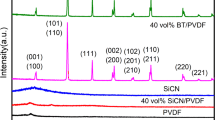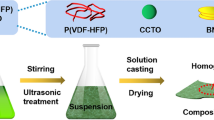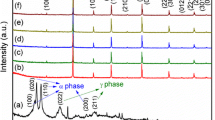Abstract
Next-generation capacitive energy storage requires novel materials with engineered nano-architectures to compete with conventional methods for energy storage. While current materials and processing strategies produce capacitors with enhanced dielectric permittivity, their breakdown strengths are low. The new fabrication route described in this paper provides flexible, free-standing nanocomposite films with high dielectric permittivity and high breakdown strength. Monodispersed ceramic fillers [BaTiO3, Ba1−xCaxTiO3 (X = 0.3 ± 0.05), and BaZr1−xTixO3 (X = 0.2 ± 0.05)] were synthesized via solvothermal method. Surface-exchanged nanoparticles were combined with polyvinylidene fluoride (PVDF) to fabricate stable polymer-ceramic blends. The PVDF/ceramic nanocomposites resulting from this approach have high dielectric permittivity, low loss tangent, and high electric breakdown strength. The calculated maximum energy densities for the BaTiO3, Ba1–xCaxTiO3 [X = 0.3 ± 0.05], and BaZr1–xTixO3 [X = 0.2 ± 0.05] nanocomposite films are 3.24, 4.72, and 7.74 J cm−3 respectively. This a result of the interplay between the dependencies of permittivity and breakdown strength on volume fraction. It is proposed that the interaction, enhanced by functionalized surface hydroxyl groups, between ceramic and polymer components is the main reason for the improved dielectric properties. This approach is versatile and is readily applicable to other combinations of polymer-ceramics composites so that cooperative properties can be exploited.




Similar content being viewed by others
References
Bai Y, Cheng ZY, Bharti V, Xu HS, Zhang QM (2000) High-dielectric-constant ceramic-powder polymer composites. Appl Phys Lett 76:3804
Chu BJ et al (2006) A dielectric polymer with high electric energy density and fast discharge speed. Science 313:334
Dang ZM, Lin YH, Nan CW (2003) Novel ferroelectric polymer composites with high dielectric constants. Adv Mater 15:1625
Puli VS, Pradhan DK, Riggs BC, Chrisey DB, Katiyar RS (2014) Investigations on structure, ferroelectric, piezoelectric and energy storage properties of barium calcium titanate (BCT) ceramics. J Alloy Compd 584:369
Lai MB et al (2013) Effects and mechanism of graft modification on the dielectric performance of polymer-matrix composites. Compos Sci Technol 89:127
Nguyen H, Navid A, Pilon L (2010) Pyroelectric energy converter using co-polymer P(VDF-TrFE) and Olsen cycle for waste heat energy harvesting. Appl Therm Eng 30:2127
Polizos G, Tomer V, Manias E, Randall CA (2010) Epoxy-based nanocomposites for electrical energy storage. II: nanocomposites with nanofillers of reactive montmorillonite covalently-bonded with barium titanate. J Appl Phys 108:074117
Xia WM, Xu Z, Wen F, Zhang ZC (2012) Electrical energy density and dielectric properties of poly(vinylidene fluoride-chlorotrifluoroethylene)/BaSrTiO3 nanocomposites. Ceram Int 38:1071
Wang Q, Zhu L (2011) Polymer nanocomposites for electrical energy storage. J Polym Sci Part B Polym Phys 49:1421
Wu W, Huang XY, Li ST, Jiang PK, Toshikatsu T (2012) Novel three-dimensional zinc oxide superstructures for high dielectric constant polymer composites capable of withstanding high electric field. J Phys Chem C 116:24887
Li JJ et al (2009) Nanocomposites of ferroelectric polymers with TiO2 nanoparticles exhibiting significantly enhanced electrical energy density. Adv Mater 21:217
Rabuffi M, Picci G (2002) Status quo and future prospects for metallized polypropylene energy storage capacitors. IEEE Trans Plasma Sci 30:1939
Wang Y, Zhou X, Chen Q, Chu BJ, Zhang QM (2010) Recent development of high energy density polymers for dielectric capacitors. IEEE Trans Dielectr Electr Insul 17:1036
Zhang QM et al (2002) An all-organic composite actuator material with a high dielectric constant. Nature 419:284
Zhou X et al (2009) Electrical breakdown and ultrahigh electrical energy density in poly(vinylidene fluoride-hexafluoropropylene) copolymer. Appl Phys Lett 94:162901
Dalle Vacche S et al (2014) Effect of silane coupling agent on the morphology, structure, and properties of poly(vinylidene fluoride-trifluoroethylene)/BaTiO3 composites. J Mater Sci 49:4552
Liu SH, Zhai JW, Wang JW, Xue SX, Zhang WQ (2014) Enhanced energy storage density in poly(vinylidene fluoride) nanocomposites by a small loading of suface-hydroxylated Ba0.6Sr0.4TiO3 nanofibers. ACS Appl Mater Interfaces 6:1533
Xie LY, Huang XY, Yang K, Li ST, Jiang PK (2014) “Grafting to” route to PVDF-HFP-GMA/BaTiO3 nanocomposites with high dielectric constant and high thermal conductivity for energy storage and thermal management applications. J Mater Chem A 2:5244
Cho WS (1998) Structural evolution and characterization of BaTiO3 nanoparticles synthesized from polymeric precursor. J Phys Chem Solids 59:659
Smith MB et al (2008) Crystal structure and the paraelectric-to-ferroelectric phase transition of nanoscale BaTiO3. J Am Chem Soc 130:6955
Kim P et al (2009) High energy density nanocomposites based on surface-modified BaTiO3 and a ferroelectric polymer. ACS Nano 3:2581
Niederberger M, Garnweitner G, Pinna N, Antonietti M (2004) Nonaqueous and halide-free route to crystalline BaTiO3, SrTiO3, and (Ba, Sr)TiO3 nanoparticles via a mechanism involving C–C bond formation. J Am Chem Soc 126:9120
Adireddy S, Lin CK, Cao BB, Zhou WL, Caruntu G (2010) Solution-based growth of monodisperse cube-like BaTiO3 colloidal nanocrystals. Chem Mater 22:1946
Mohanty D et al (2012) Synthesis and piezoelectric response of cubic and spherical LiNbO3 nanocrystals. RSC Adv 2:1913
Li CC, Chang SJ, Lee JT, Liao WS (2010) Efficient hydroxylation of BaTiO3 nanoparticles by using hydrogen peroxide. Coll Surf A—Physicochem Eng Asp 361:143
Acknowledgments
This work was supported by the NSF-EFRI Award # 1038272 Grant. This work was supported in part by the Tulane/Xavier Center for Bioenvironmental Research.
Author information
Authors and Affiliations
Corresponding author
Rights and permissions
About this article
Cite this article
Adireddy, S., Puli, V.S., Lou, T.J. et al. Polymer-ceramic nanocomposites for high energy density applications. J Sol-Gel Sci Technol 73, 641–646 (2015). https://doi.org/10.1007/s10971-014-3573-4
Received:
Accepted:
Published:
Issue Date:
DOI: https://doi.org/10.1007/s10971-014-3573-4




